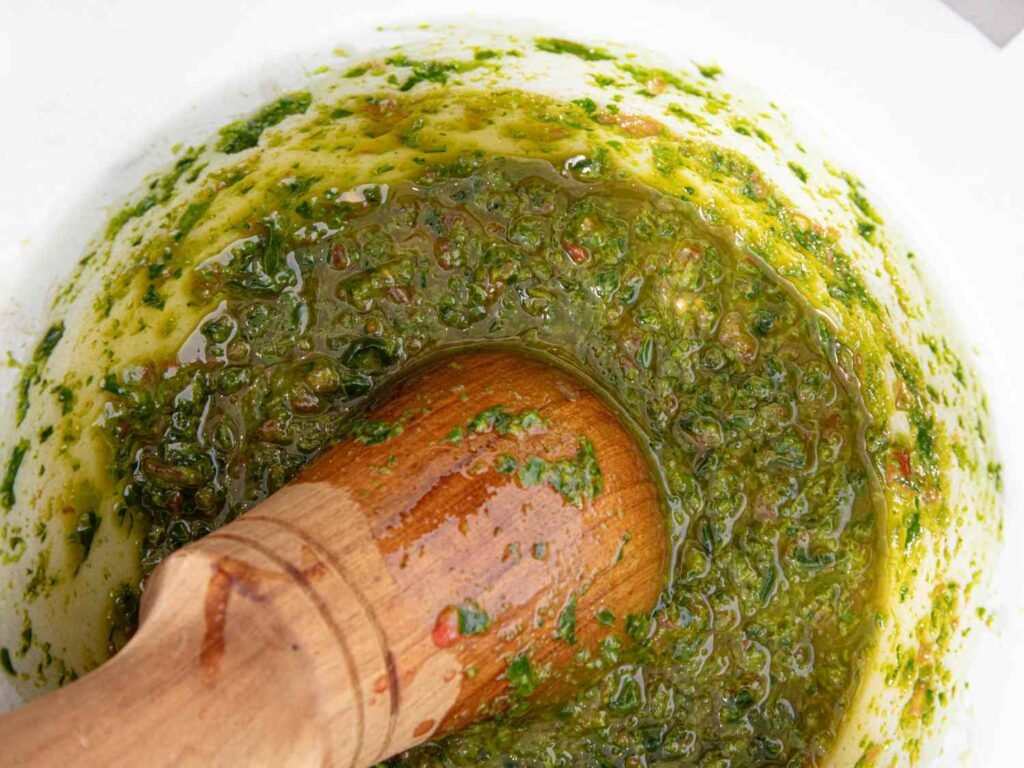Why It Works
- Freezing the basil leaves helps pre-tenderize them for easier crushing or blending, and also helps retain their green color.
- You choose your tool: A mortar and pestle creates the most aromatic and flavorful sauce with the silkiest texture, while blender and food processor methods are by far the fastest and easiest.
The classic pesto alla genovese has spawned many an offspring, including Sicily’s tomato-infused trapanese pesto, and scores of modern reinterpretations (arugula pesto, anyone?). Perhaps the one that resembles it the most in appearance and flavor is France’s pistou, which comes from Provence and is typically stirred into a comforting summer soup. But pistou has key differences from its Ligurian cousin, and you may be glad to learn that those differences make pistou even easier and less expensive sauce to whip up.
Made from just four key ingredients—garlic, basil, olive oil, and salt—pistou has all the herbal aroma and allium punch of pesto, but usually doesn’t include the cheese and pine nuts found in typical pesto. That makes it not only a simpler and more affordable sauce, but also one that works for vegans, those with nut allergies, and those who are cheese-averse.
In many recipes, a little something extra is stirred into pistou at the end. Sometimes it’s a ladleful of the soup with which it’s often served, but frequently it’s a bit of fresh, finely diced tomato, which adds a sweet, fruity note that softens and rounds out the sauce; my recipe below calls for tomato.
Serious Eats / Amanda Suarez
I love any excuse to bust out my mortar and pestle, and this sauce is the perfect reason to do so. The crushing and grinding action of the pestle breaks open the cell structure of the garlic and basil, releasing more flavor and aroma than the chopping blades of a blender or food processor do, and the result is silkier—composed less of very finely minced bits and more of ultra-softened shreds. That said, the speed and convenience of a blender or food processor can’t be denied, and good ones do an excellent job of producing a smooth and flavorful sauce. This recipe offers instructions for both methods.
One last note: If you want, you can pop the basil leaves into a freezer briefly before making the sauce, just long enough to turn them rigid. The ice crystals that form in the leaves break apart the cells, softening them before crushing or blending. At the same time, the cold temperatures temporarily deactivate browning enzymes that can cause the basil leaves to turn an unpleasant, drab color shortly after crushing or processing.
As for how to use the pistou, the possibilities are endless: in the classic soup; on toasts; on eggs; on sandwiches. It’s particularly great on pasta or spooned over roasted or fried potatoes (or really on just about any starch). Put another way: Anywhere you might enjoy some pesto, pistou would be just as welcome.
Pesto’s French Cousin Tastes Like Summer in Provence
Cook Mode
(Keep screen awake)
4 medium cloves (20 g) garlic
Medium-coarse sea salt or kosher salt
2 cups (60 g) picked basil leaves (frozen if desired for easier puréeing and color retention)
1/2 cup (120 ml) extra-virgin olive oil
2 whole plum tomatoes (about 7 ounces; 200 g total), peeled, seeded, and minced
If using a mortar and pestle: Using a mortar and pestle, crush garlic with a pinch of salt until sticky and pasty, and no chunks remain. Next, pound in basil, a handful at a time and adding salt as you go, making sure leaves are well pounded and no longer stringy or in large bits before adding the next handful; salt acts as an abrasive and helps break down the basil, but be careful not to add too much and make the pistou too salty. Pound in the olive oil, then stir in the minced tomato.
Serious Eats / Amanda Suarez
If using a blender or food processor: Process garlic with the basil, olive oil, and salt, stopping to scrape down sides as necessary, until a smooth sauce forms. Stir in minced tomatoes.
Make-Ahead and Storage
The pistou is best eaten shortly after making, but it can be refrigerated in an airtight container for up to 2 days.
Special Equipment
Mortar and pestle, or blender, or food processor


